This guide will teach you how to sustainably acquire new users, use marketing automation to onboard them into your product and grow them into satisfied, profitable customers through an approach called relationship marketing.
The most costly mistake growing companies make is over-investing in "top of funnel" metrics like lead acquisition and product sign-ups, before they ensure their product and messaging connect with what motivates their customers.
The inevitable result: massive amounts of time and money wasted not just on acquiring users that are a poor fit, but also on users that are actually the perfect fit — but they either don’t convert, or churn later on in the lifecycle, because they’re never shown how the product adds to their lives in a way that speaks to them.
And once they’re gone, they nearly never come back.
As businesses increasingly rely on subscriptions, repeat transactions, and add-on services to generate recurring revenue, the lifetime value of each customer relationship matters much more than the initial purchase. But the growth models most marketers follow focus on lead generation and "nurturing" that’s really about closing the sale ASAP, with no regard for what happens after.
This is unsustainable for any company — but for startups with limited time and runway to find their market and reach profitability, it can quickly prove fatal.
Relationship marketing optimizes the value you generate from your relationships with customers before you pour all of your resources into acquiring them, while also helping each of your users meet their own goals.
This guide is dense by design, built to teach you how to create impactful relationship marketing from start-to-finish, from the core concepts to real-world applications with examples from companies like Intercom, Mailchimp, HubSpot, Superhuman and others. It’s not a quick read, but it’s simple to understand and — I genuinely believe — will make a positive difference in how you work.
Rather than breaking things up into many bits-and-blog-posts, I hope for this to be a comprehensive resource that helps product marketers, designers, developers, managers and executives grow the health of their business and their relationships with customers. I encourage you to read it at your own pace and take breaks to reflect on each section.
By the end of this guide, you’ll know how to:
Create messaging and content that speaks to your users’ motivations
Use marketing automation to drive engagement across the customer journey
Measure and optimize the metrics that indicate healthy product-market fit
What is product-market fit?
Product-market fit describes the state of a company’s growth when its product resonates with a “good market” — one both sizable and monetizable. It’s the level every startup aspires to reach, and where every industry titan aims to remain.
But how exactly do you get there? It’s not just about having a great product. You also need to reach an audience that’s ready to enthusiastically embrace it, which doesn’t just happen on its own.
Many companies assume that they’ve achieved product-market fit as soon as they’ve received some positive feedback and closed a few early deals, but this is a dangerous assumption for two major reasons:
The behavior of early adopters doesn’t represent how the broader market will perceive your product. Early adopters tend to be more aware of their specific needs and desired outcomes, and more willing to try out new solutions. Reaching a “good market” — the whole market — requires expanding beyond those early adopters to users who require more education and persuasion.
Customers are still testing out whether a product really solves their problems long after they’ve first tried it out or even paid for it. Meanwhile, competitors in your market will constantly be sharpening their offerings and vying for the same users as you. You can’t be certain you’ve achieved product-market fit without first measuring that you’re meeting your customers’ expectations over the long term.
Ben Horowitz, co-founder of the venture capital firm Andreessen Horowitz, outlined these four myths of product market fit:
Product market fit is always a discrete, big bang event
It’s patently obvious when you have product-market fit
Once you achieve product-market fit, you can’t lose it
Once you have product-market fit, you don’t have to sweat the competition
What these myths tell us is that product-market fit is not something predestined; it’s something that can be manipulated and measured, and must be measured to be sure you’ve actually achieved it.
I humbly propose a fifth myth of product-market fit: “Your product should sell itself without marketing.” This myth is based on a misunderstanding of what modern marketing is. It’s no longer simply about advertising and branding; it’s about understanding what motivates customers, delivering on those motivations and constantly measuring the impact.
Relationship marketing is designed to do just that.
How relationship marketing helps
Relationship marketing focuses on growing and measuring the lifetime value of every customer relationship, starting with the very first interaction.
Prospect and customer acquisition are still important, but instead of seeing them as primary goals, they’re simply milestones measured across a larger — and far more valuable — customer journey.
The problem with most growth frameworks is that they don’t realistically represent a customer’s interactions with a company. A typical “growth funnel” looks something like this:
This “growth”-centric view of the customer journey is focused entirely around the business’s priorities, not the customer’s. While your business has specific goals it needs to meet, it will always struggle to meet them if those goals are misaligned with your customers’.
By contrast, relationship marketing looks at each step of the customer journey from the user’s perspective.
At each stage, you’ll help users understand more about their problems, motivations and the potential for your product to deliver meaningful outcomes, using the three fundamentals of relationship marketing:
Audiences: A research-based understanding of your customers and what motivates them.
Automation: Marketing automation tools that allow you to deliver timely and relevant content.
Content: Messaging that speaks to your audience’s motivations and removes the obstacles in fulfilling them.
Along the way, you’ll measure the impact of your efforts at each stage, and tie it all back to metrics that indicate sustainable product-market fit.
Audiences
To create marketing that speaks to your market’s motivations, you first need to understand exactly what those motivations are. At which moments do your potential customers first realize they have a need to be met? What do they hope to achieve with your product? And how can you help them get there?
One popular approach to defining marketing audiences is through personas, which HubSpot defines as “fictional, generalized representations of your ideal customers.” The goal of personas is to build empathy with real users, and give focus to those who make and market products. Here’s Sample Sally from HubSpot’s persona creation worksheet:
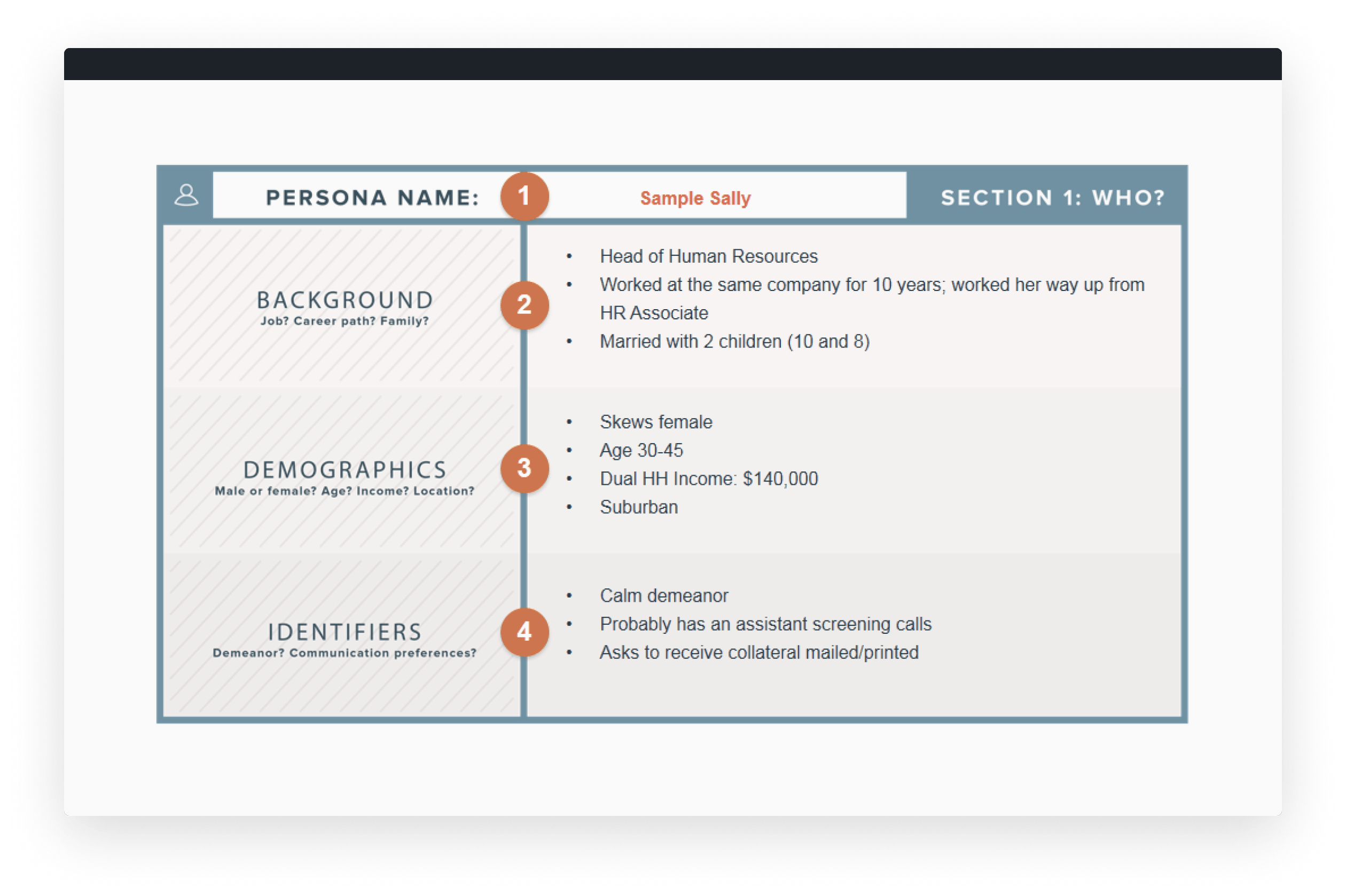
The problem with personas, though, is right in the definition: they’re fictional and idealized, representing not who your customers really are but who you think your customers ought to be.
Even the best-researched personas can fail because they ignore that very different people can be motivated by the same challenges and desires; in the worst case scenario, they can lure companies into confidently creating things for audiences that don’t really exist.
Paul Adams, VP of Product at Intercom, and previously a designer and researcher at Google and Facebook, explains why Intercom doesn’t use personas:
"Personas artificially break apart audiences. And critically, they artificially limit your product’s audience by focusing on attributes rather than motivations and outcomes. Once I made this observation, it blew apart my faith in personas. [...] Personas explain who people are and what people do. But they never fully explain why people do something. And why people do things is far more important."
It’s impossible to know why people do things without talking to them about it, but many organizations assume that they already understand why users choose their product and what they like about it, without doing much to verify whether that perception aligns with users’.
When you actually speak with customers, you discover that they use your product in ways you’d never thought of, and talk about it with powerful language you’d never considered using (but very much should). It’s not uncommon to discover that a way a company perceives its own product and its value differs greatly from what their users see in it, and why they choose it over other options.
That perception can even differ greatly between the individuals and teams inside the business, making delivering a consistent message to customers impossible. A quick survey of your organization before embarking on customer research will help you better understand where you’re starting from.
Have each member of your team independently write 1–2 sentence answers to the following questions:
How would you describe what [our company] does when speaking to a potential customer?
How would you describe what [our company] does when speaking to an industry colleague or friend?
Why do customers choose us over our competitors, such as [X, Y and Z]?
What do customers love most about our product?
What are our current customers' biggest challenges?
Compared to your internal survey, your customer interviews should feel more free-form and organic. Let customers go on tangents and always ask “why?” to dig for deeper details (and record the audio of each interview so you don’t lose track of them all). Some questions to consider incorporating into your interviews include:
What was your life like before using our product? What’s changed since?
What was the moment that made you decide to take action?
What problem were you trying to solve? Does our product solve it?
Why did you choose our product over others?
What do you like most and least about our product?
What are the biggest challenges you’re facing today?
When reviewing the recordings and/or transcripts of interviews with users, look for common themes in the circumstances that brought them to your product, the moments at which your product delivered the most value and the struggles they still face. If there are words or phrases that come up again and again, you’ll want to make them central to your product’s messaging.
With results from colleagues and customers ready for review, ask yourself the following questions:
Is your company’s internal perception consistent, or does it vary between individuals? Between teams?
Regardless of whether your internal perception is consistent or not, how does it align with how your customers perceive your product?
Do your customers mostly have similar motivations to each other, or are they driven by different desires?
How and when do your customers’ motivations and perception shift as they become more familiar with your product?
Mapping the motivations
Your interviews with colleagues and customers will give you the knowledge necessary to begin mapping out what motivates users at each stage of the customer journey.
All motivations start with a desire to change something in the status quo of life. What pains, needs or ambitions are driving your users to desire change? For each motivation at every stage of your customer journey, include:
Obstacles: What prevents your users from fulfilling each motivation, whether with or without your product?
Moments of truth: Which events or interactions most impact your users’ perception of their problem or your product, positively or negatively? Traditionally the term moments of truth is used to refer to interactions between a customer and a brand, but you also want to track any major moments that might have impacted their motivations, even if your company wasn’t involved.
Customer quotes: Which quotes from your customer interviews most strongly support the identified motivations, obstacles and moments of truth?
Doing this research up-front isn’t as time-consuming as it might seem, and removes friction from everything else you do while instilling research-based confidence that you’re building the right things for the right market.
Recap on audiences
Gaining new customers in any market requires repeatedly delivering a message that resonates. But many companies rely on assumptions of what users should look like and value without going straight to the source. Rather than focusing on demographics and personality, identify what motivates your users to take action, what obstacles they face in doing so, and the precise language they use when discussing it.
Automation
It’s impossible to manage every customer relationship hands-on as you scale up. Marketing automation platforms are what allow you to:
Store and view the status of each customer relationship. You can track which pages your users visit, which emails they open, which features they use, information submitted through forms, and nearly any other information about how a user interacts with your digital properties.
Automatically send the right content at the right moments. Based on who your users are and what they do, deliver content that speaks to their needs and motivations in the moment.
There are many marketing automation platforms, and they vary greatly in cost and complexity. However, all of them are capable of handling the basics of tracking user behavior and building workflows.
What are workflows and how do you build them?
Workflows are sequences of preset actions you build that are automatically triggered to launch based on who your users are, what they do and when they do it.
A few extremely simple workflow examples:
If a user leaves the site with items in their cart, send them an email reminding them to check out. (The ubiquitous “abandoned cart” email)
If a user never opened email A, wait 3 business days, and then send them email B.
If a user visited pages in category X on our website before becoming a contact, send them content relating to category X.
No matter which marketing automation platform you choose, workflows have the same basic components everywhere.
Enrollment triggers: These determine which users will enter each workflow and when. This can be based on action they take (such as viewing a page, clicking a link in an email or submitting a form), information in their profile (i.e. a job title, a stated budget, or information sent from your application), or their membership in a specific contact list. You can also manually add users to a workflow.
Actions: Once enrolled in a workflow, each action will be executed in the order it’s been built. The most common actions include:
Sending an email to the contact
Sending an email to an internal team member
Sending an in-app notification
Setting a value in the contact’s profile
Adding the contact to a static email list
Enrolling the contact in another workflow
Creating an open deal in a sales CRM (like Salesforce)
Triggering a webhook in an external application — meaning you can do anything you can technically implement
Delay: This pauses the workflow for a set period of time before executing the next action. If you don’t put a delay between actions, they execute immediately one after the other, so they’re especially necessary to avoid bombarding messages with users. It’s also important to include them before checking whether a user has done something using an if/then branch in order to give them time to take action.
If/then branch: This branches the workflow into two different directions depending on whether the user has taken a specific action, or a value in their profile has reached a certain threshold — the same types of factors you would use to enroll users in a workflow in the first place. The more reactive your workflows are to user behavior, the more branches you’ll want to include.
In addition to triggering messages to contacts, workflows can also be used to pass a contact into your sales pipeline. But remember that qualified leads are contacts that have expressed a clear interest in your product, not just anyone that hands over their email address.
Lead scoring — is it worth it?
Lead scoring is the practice of assigning a numerical score to each user in your database in order to identify “qualified” leads, usually to pass off to and be prioritized by a sales team. Points are applied based on both profile information about the user and the actions that each user takes, such as reading an article, visiting a pricing page or clicking a link in an email.
The below example adapted from Marketo’s “Definitive Guide to Lead Scoring” highlights many of the problems with lead scoring.
In the example, both Crissy and Jen have earned 36 points based on their behavior. But it’s clear that Crissy’s actions indicate far more potential to purchase, whereas Jen’s actions indicate more of an interest in the company’s content.
So what information or benefit is the score actually adding here? When you remove the scores, the trajectory of each user actually becomes clearer. The scores create an equivalency between actions that isn’t really there.
Most of the user actions in this example, especially on Crissy’s side, should already have follow-up workflows attached that reflect specifically the content the user interacted with. So the scores aren’t that helpful in triggering follow-up actions either.
Implementing lead scoring is also far more complicated than other forms of marketing automation, and not only from a technical perspective (although there’s a reason the practice is largely promoted by software vendors). The process of choosing a score for each relevant action a user can take is extremely time-consuming, and choosing ones that accurately reflect the weight of those actions is all but impossible, to say nothing of tuning them over time.
Lead scoring can be effective in prioritizing which active leads to follow up with and in which order, but this is only valuable if your business’s major bottleneck is having way more qualified leads to follow up with than sales people to do so.
Worryingly, lead scoring is often implemented in the exact opposite situation — a sales team need more leads, so marketers are tasked with creating content to collect email addresses en masse, to be passed off to a sales rep after the slightest sign of activity. But this indicates nothing about a user’s likelihood to buy.
Scoring doesn’t solve this issue. Instead of trying to guess whether users are ready to talk or to buy, use your content and workflows to create pathways that help them let you know.
Recap on automation
Marketing automation tools allow you to build a persistent profile of a contact’s behavior and any information they’ve submitted to you. Based on that information, you can build workflows that give you complete control over what content users receive, and when and where they receive it. This allows you to send the right information at the most opportune moments, so you can always guide each user towards the next step in fulfilling their motivations — and give them the confidence to take it.
Content
Content in your relationship marketing strategy encompasses nearly everything your users see and interact with, including your website and landing pages, emails, PPC and display advertisements, articles, webinars, surveys, social media presence, live chat, in-product copy and more.
It can be easy to get overwhelmed in the flurry of methods and mediums, figuring out which ones to apply to each stage of the customer journey. But truthfully, most of the mediums listed above can be valuable at every stage. What matters most is not the medium, but the message.
This is where your audience research comes into play, giving you the insights you need to create content that, across every channel and at each stage of the customer journey:
Reflects and encourages growth in your users’ motivations
Helps users eliminate obstacles or provide alternative means
Guides users towards experiencing positive moments of truth
The goal of the content you send is always the same: encourage the user to get to the next stage of the customer journey. It does this in two ways:
The content at each stage of the customer journey speaks directly to the needs, desires and objections of users that you identified during your audience research, empowering them to confidently purchase and use your product.
When users interact with content (e.g. opening an email, clicking a link to an article, and then clicking another call-to-action on that article), we gain insight into what interests them and what they already know, which we can use to better tailor future content to them.
In the following sections, we’ll dig deep into what content looks like at each stage of the customer journey and how to apply all of these fundamentals. But here are some high-level tips to apply at every stage:
Don’t send the same content to everyone
You don’t need eight different personas each with their own complex workflows, but you also don’t want every single person to have the exact same experience. This is especially important immediately following a conversion; if someone gives you their contact information after reading an article, for example, ensuring the first follow-up communications are hyper-relevant to what they were just reading about is a strong start that can help keep you in their good books (and their inbox).
Don’t overload your content with calls-to-action
When you want users to click on or do one particular thing, the worst thing you can do is give them a dozen things to click on and do. It also makes it more difficult to track what’s working and what isn’t. That isn’t to say you should never have a secondary call-to-action, but they should be the exception rather than the rule.
Talk about them, not you
Your prospects and customers don’t want to hear about how awesome your product is—they want to know how it makes them awesome. Discuss your product only in terms of how it can help them solve problems and overcome challenges, using language taken straight from your own customers during your customer interviews.
This now-classic image from UserOnboard.com succinctly breaks down the difference between selling your product and selling the outcome:
Reuse content when you can, and know when you shouldn’t
Content creation can be expensive and time-consuming, so look for opportunities to reuse the content you’ve already created in new formats, or break larger content pieces down into smaller chunks. But recognize when your existing content no longer makes the cut or isn’t the right fit; if your audience research reveals that you’ve been talking about your company completely differently from how your users perceive it, you may have to go back to the drawing board.
Recap on content
Your content consists not just of your website, articles and emails, but also your branding, advertising, and even your product itself. It’s everything the user sees and interacts with, so tailor it to what they’re looking to accomplish in the moment, framed in their language, rather than focusing on your business goals and product features. Content that confuses your audience or doesn’t speak to their needs is likely to do more harm than good. Take advantage of automation to deliver the right content to the right audiences and avoid repetition.
Stage 1: Awareness
Associate your brand with the users' burgeoning motivations in a memorable and positive way.
At the earliest stage of the customer journey, your user’s motivations are just beginning to take form. They might have an idea of what they want to change, but their knowledge of why and how to act on those motivations can be lacking; or they could have frustrations stemming from problems that they themselves are yet to become aware of.
Content at this stage should help your prospects define their own problems and potential, and position your brand as an expert in understanding and realizing them.
Basecamp co-founder Jason Fried wrote in Getting Real, “The best software has a vision. The best software takes sides. When someone uses software, they’re not just looking for features, they’re looking for an approach.” Features are replicable commodities. Perspectives, your brand can own.
That’s one reason why some brands attempt to establish their own unique industry language, such as HubSpot with inbound marketing and Drift with conversational marketing, both of which have contributed immensely to the traffic and mind share to their respective companies and served as the basis for countless articles, presentations and books.
In an interview about how Drift developed the term conversational marketing, their VP of marketing Dave Gerhardt spoke to the power of looking to your customers’ words for inspiration: “I could spend hours writing copy for our website, but the best copy I could use is when somebody else actually said it.”
It was only once new customers started using the term on their own that they knew they were onto something. “It became easier for those businesses to tell other people, “Oh yeah, we use Drift. ‘It’s conversational marketing.’ We enabled them to tell more people because it’s easier.”
Plenty of other companies try to establish similar language, whipping up buzzwords in the hopes of discovering the next SEO honeypot — but buzzwords invariably fail to catch on. The companies that succeed most at creating new terminology do so when they genuinely make it easier to understand the value in something, and to communicate that value to others.
But you don’t necessarily need to create a catchy new phrase to accomplish that goal. Sometimes the secret is in discovering the very straightforward messages that are already resonating with your target audience.
Prior to launching, Rahul Vohra, CEO of the email startup Superhuman, knew that their product wasn’t hitting all the marks with early users. In a piece for First Round Review, "How Superhuman Built an Engine to Find Product/Market Fit", he describes his experience building product-market fit by zeroing-in on what his most hardcore users loved most. And their feedback was nearly unanimous: speed!
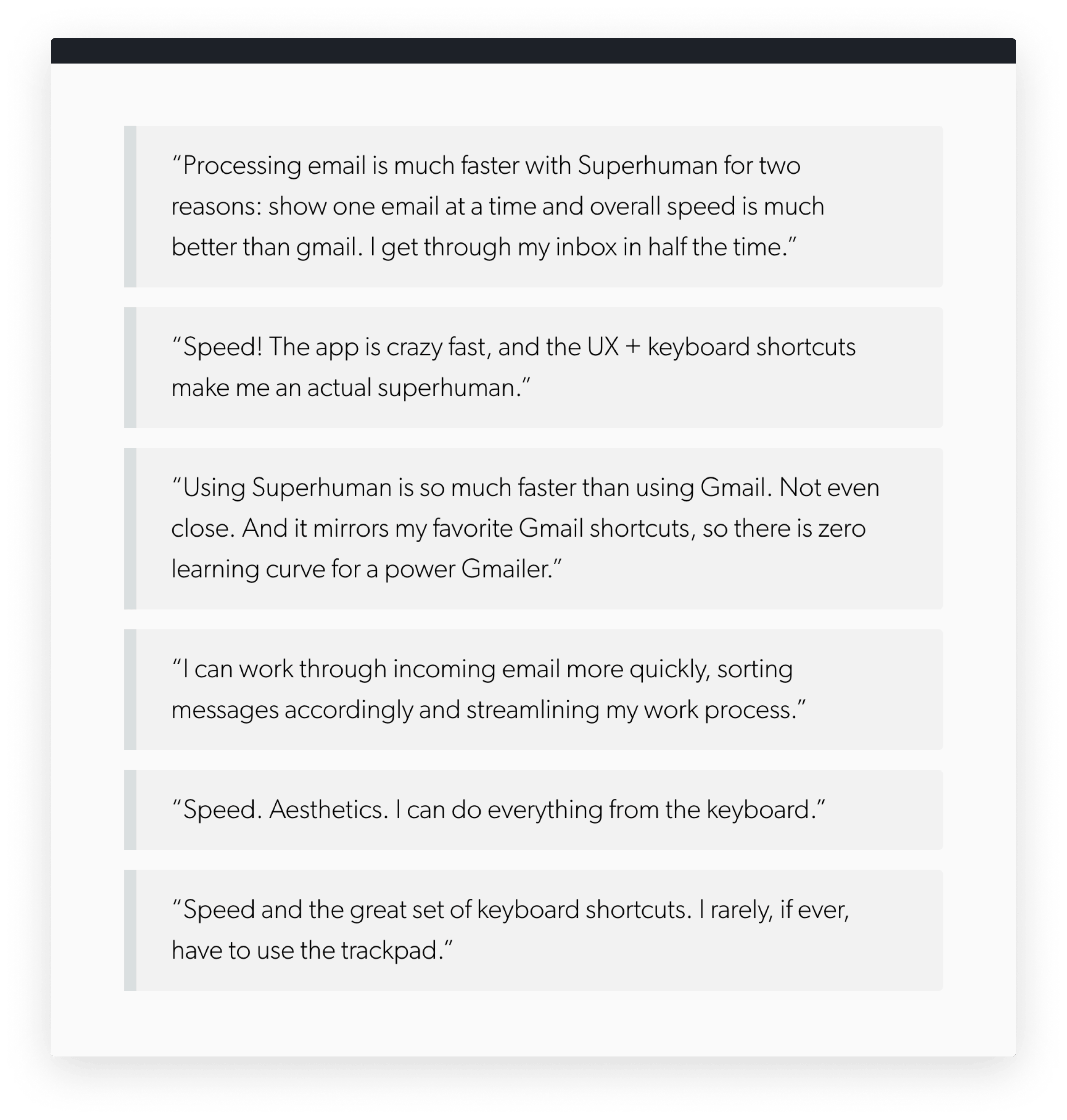
Visit Superhuman’s website today, and you’ll see those customers’ feelings presented front-and-center to first-time visitors. While this messaging is feature-heavy (pretty much a necessity for an email app), it’s still focused around the outcomes it can create for the user.
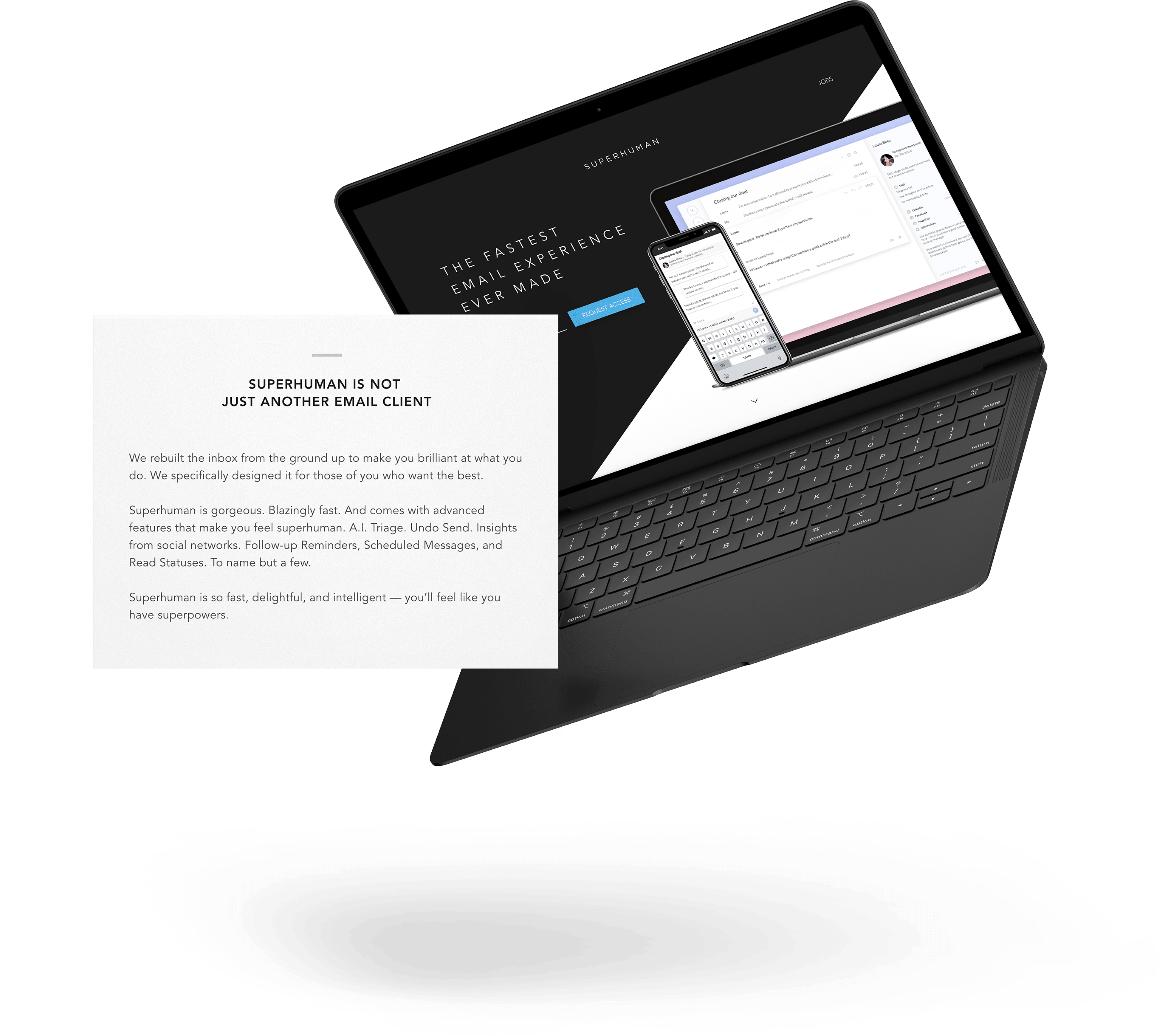
Superhuman reiterates the value of speed across all of its marketing and onboarding materials, letting those that prioritize speed know that this is the email tool for them, while helping those that hadn’t considered the impact of faster email envision a better future — using language lifted straight from those who are already living it.
Recap on the awareness stage
Messaging is important at every stage of the customer journey, but especially so in the awareness stage. It’s your first (and often only) shot to create a connection with a prospect, and forms the foundation of everything they learn about your product later in the customer journey. Effective marketing cannot exist without effective messaging, and the most effective messaging is both memorable and illuminating, making it easier for users to understand the positive impact your product can bring to their lives.
Stage 2: Education
Give users the knowledge they need to confidently pursue their motivations, positioning your brand as the perfect partner.
At this stage, users are fully in tune with their motivations and aware that your product can potentially help them take action. But they may not necessarily feel confident in getting started, or that your product is the best option on the market to help them. Your goal in this stage is to build the user’s confidence that your company can help them achieve the outcomes they want.
One company that consistently nails this in their content is Intercom. As a customer acquisition and engagement platform, the results Intercom can deliver to customers are completely dependent on them being effective marketers.
In addition to its Inside Intercom blog, where Intercom employees and executives frequently share their own insights on marketing and customer engagement, Intercom also offers a rich library of guides and books designed to give readers a crash course in all of the scenarios in which Intercom can deliver value … but without making it all about their product.
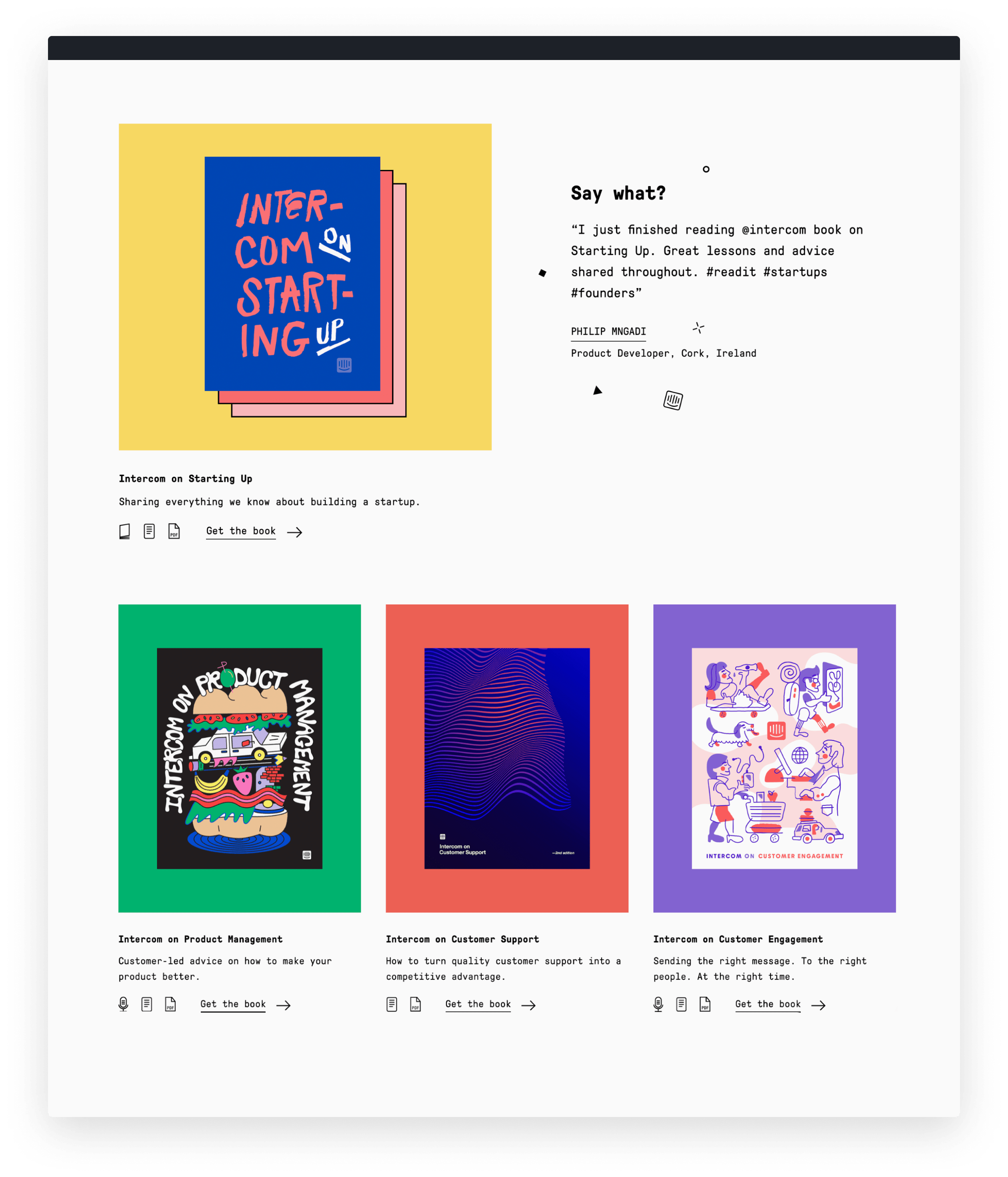
Sure, the title of every book contains the word "Intercom," but that doesn’t refer to Intercom the product; it refers to Intercom the company. Intercom reinforces their expertise in their customers’ problems by consistently using lessons learned from running their own company as examples. They sparingly mention Intercom’s product in these pieces and when they do, it’s in passages that look like this:
“We’re obviously biased and think Intercom is the best way to engage your customers but our advice remains the same regardless of the tool you’re using."
That trend carries over to their email follow-up, seen below. The primary call-to-action leads to a podcast with text transcript about writing high-converting copy, a perfect complement to the book on customer engagement that I downloaded.
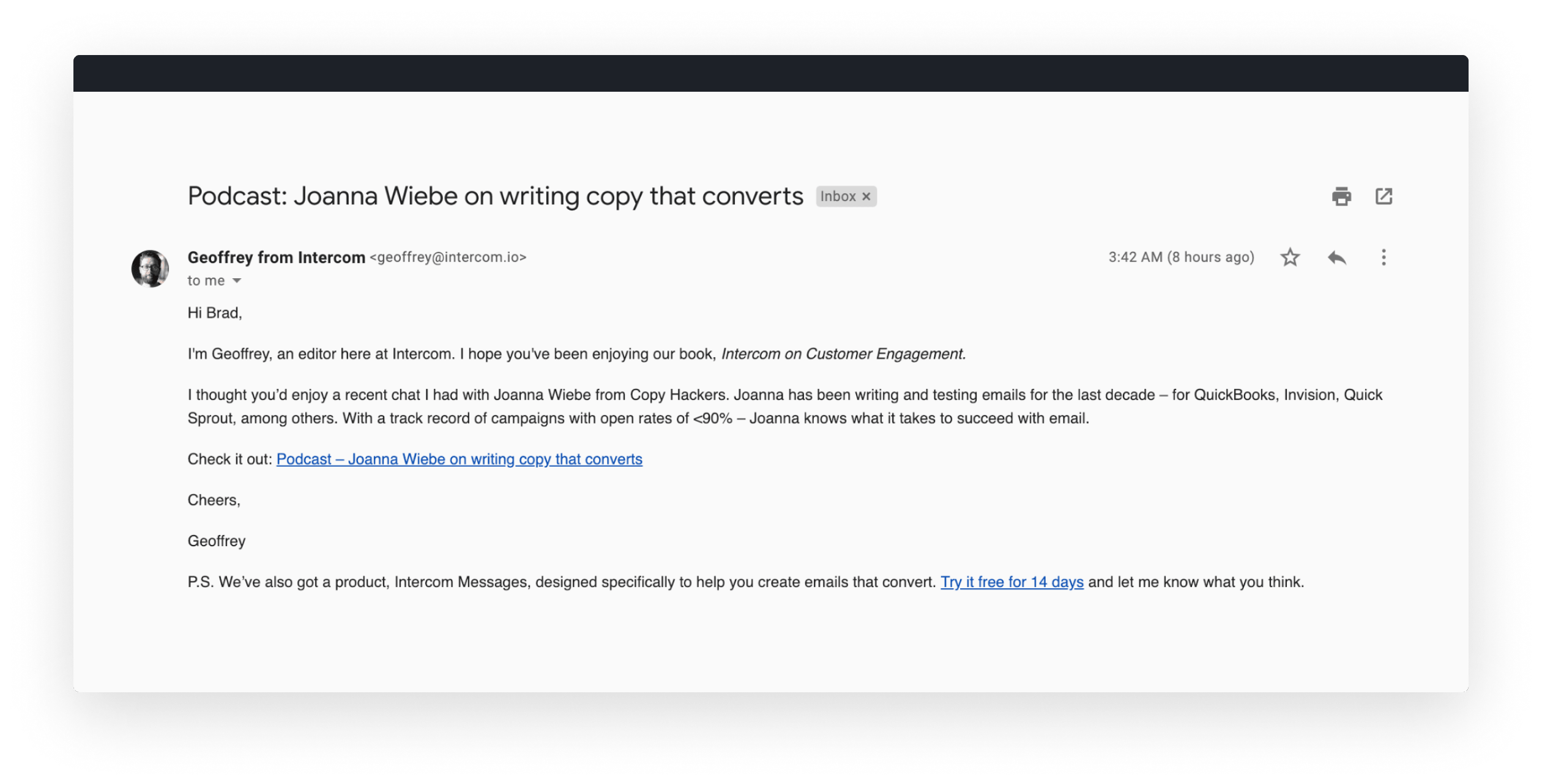
They wait until the postscript of this email to even mention that Intercom has a product, and link to a landing page that’s specifically about customer engagement, the goal that I’ve expressed clear interest in.
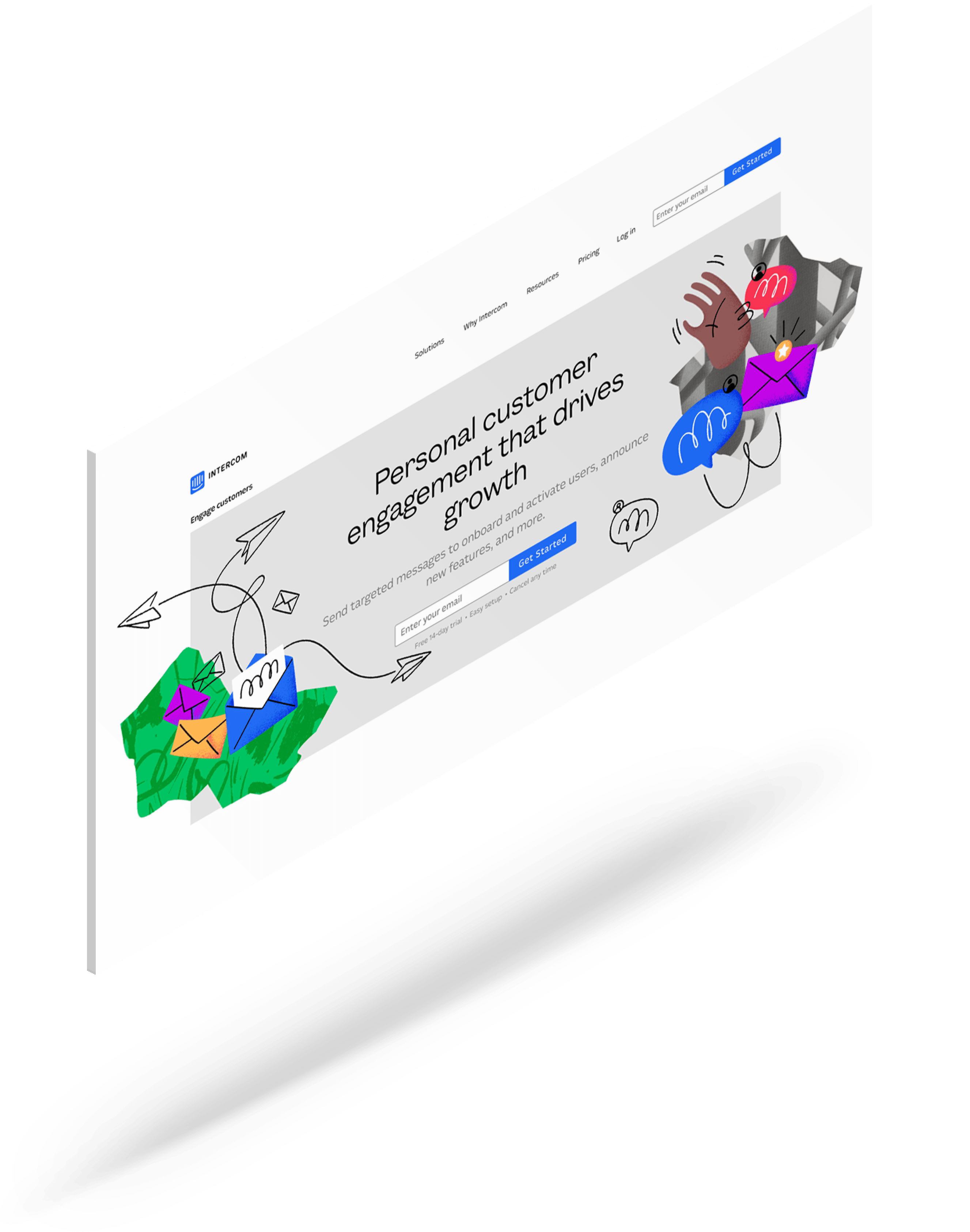
They also have different pages like this for customer acquisition and customer support, each with unique content designed to speak to the different motivations that bring people to Intercom.
Handing off to sales — the right and wrong ways to do it
If a user is frequently visiting product-related content — like features and pricing pages — now is the right time to have a member of your sales team introduce themselves and offer to help.

The above email from Jack at Intercom works for four reasons:
It’s brief. It’s easy to tell if it’s relevant, and ignore it if it’s not.
It’s not aggressive. There are no calls-to-action to click. It’s just a simple offer to help, with the option to reply if I want it.
It asks a qualifying question. If I answer this, Intercom knows that I’m a qualified lead and exactly what I’m looking to accomplish. If I don’t, they can assume I’m not interested.
It’s easy to opt out. This opt out link only unsubscribes me from receiving sales emails from Intercom, so I can still get their great content.
The below email from Jacob, from a company I’ll withhold naming, illustrates exactly the wrong way to do things. All I did was download a simple infographic, and then ...

The problems:
It’s impersonal and insincere. The email begins with “I saw that you recently downloaded a piece of content we created here at [Company],” a clear sign that anyone that downloads anything will get this email. And it makes everything that follows, like “I'm impressed that you're taking the time to continue learning,” and “When I speak with others in your space,” sound even more patronizing.
It’s about them, not me. Most of the email is a list of product features, with the only outcomes being vague promises of “growing more efficiently and effectively”, “reducing busywork” and “staying on the cutting edge.”
It’s too aggressive. Jacob links me to three case studies totaling over 2,000 words and then asks me if I have 10 minutes to talk today. In fact, that’s the only thing he asks me. And the call-to-action is to… book a “qualification” call.
I can’t opt out. There is no link to unsubscribe in this email, a horrible experience for users that can lead to your emails getting junked and your domain blacklisted. Worse, it’s in violation of anti-spam laws in the US, Canada and Europe.
But the biggest problem is the email Jacob added to the thread the very next day:
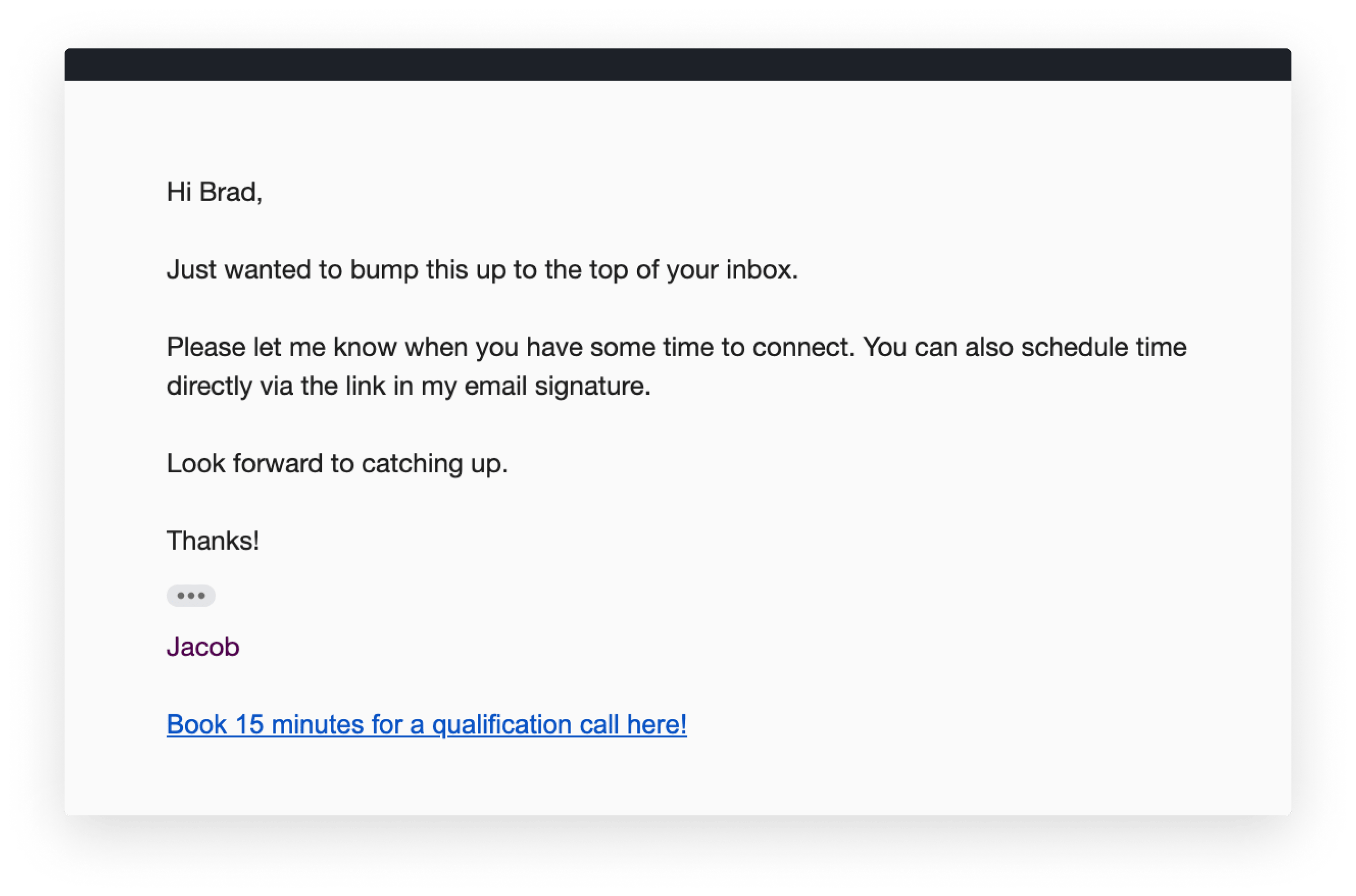
“Just wanted to bump this to the top of your inbox.”
I’m getting the sense that what I want doesn’t matter very much here.
Recap on the education stage
Continue building on the expertise your brand has established with your messaging so far, using the information you’ve collected about each user within your automation tools to drive users towards content tailored to their specific motivations, helping them envision what positive solutions look like and where your product fits in. Resist the temptation to drive users straight towards the sale or sign-up, as this won’t necessarily lead to more engagement or revenue. When users are ready to talk or to buy, they’ll be happy to let you know — so be sure you make it easy to do so.
Stage 3: Onboarding
Guide new users towards discovering value in your product as quickly as possible.
In late 2018, Mailchimp made waves with a dramatic rebrand to position itself as not just an email marketing company, but an all-encompassing marketing automation tool for growing businesses. But of course, they kept the name.
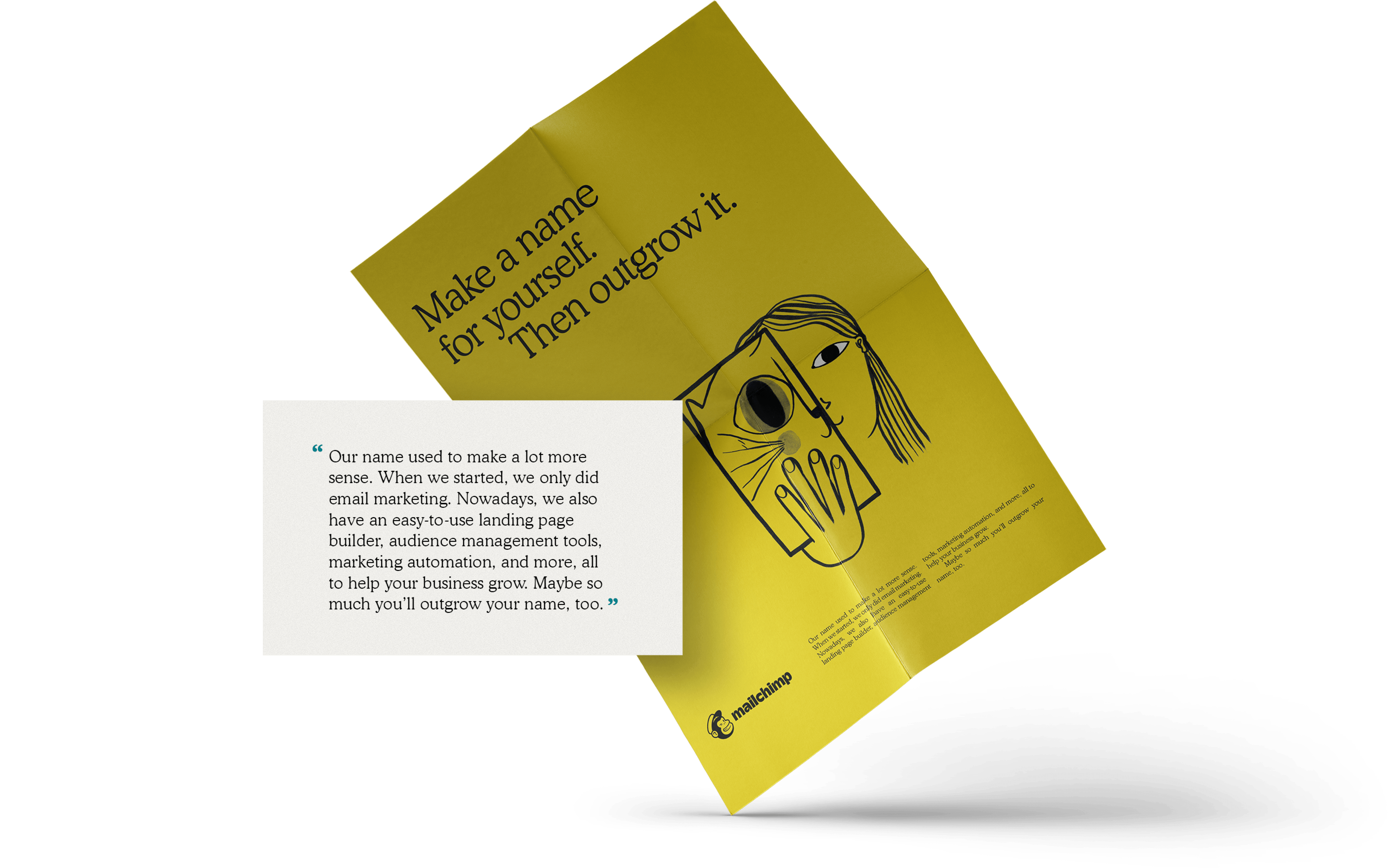
Mailchimp began as a basic email builder, but it has added many features over the years in order to strengthen its product/market fit with its users and expand into more valuable markets. But most of its new features have one thing in common: they help you get more subscribers. Mailchimp’s core function as an email marketing tool can’t create value for users that don’t have a list of subscribers to email.
That priority is also reflected in the onboarding content Mailchimp emails to new users, across a series of ten emails which arrive every four days following the creation of a free account.
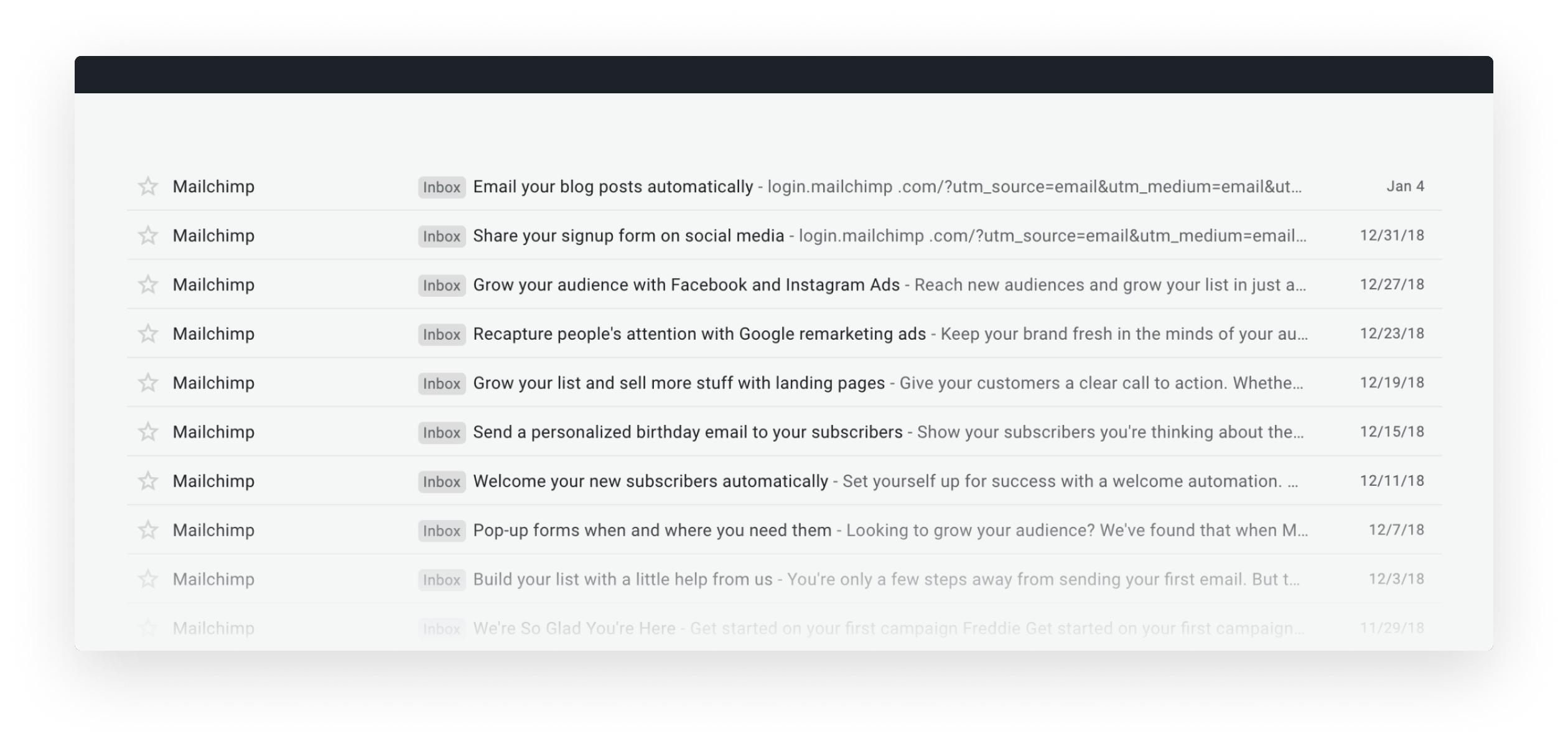
A sampling of the subject lines featured here:
Build your list with a little help from us
Pop-up forms when and where you need them
Grow your list and sell more stuff with landing pages
Grow your audience with Facebook and Instagram Ads

As you’d expect from Mailchimp, the format of these emails is clean and easy-to-read: a bold headline, short description, clear call-to-action, and secondary links to content underneath that support users in achieving the primary goal. Giving an estimate of how long each action takes to complete is a nice step towards reducing a user’s hesitancy to get started.
While this campaign gets a lot right, it also misses some major opportunities. I barely opened any of these emails and clicked through exactly none of them, yet they continued to arrive at the same cadence until the workflow ran out of content to send, 10 emails and 36 days later. And then literally nothing else ever again. Why?
Marketing automation makes it simple to track and trigger events based on what the user does or does not do. Crucially, this means that we can measure if something isn’t working and try a different approach.
Re-frame the goal in a different message
Each of these emails has the same format, and the most prominent call-to-action is always directly back into the product. If users aren’t engaging with a piece of content like an email, it’s worth trying to discover if it’s due to the message or merely the format by sending a new piece of content about the same topic.
For example, the email above promoting landing page functionality promises to help users “get your site out of the way” and links directly into the app to start building a landing page. This messaging assumes that the user already sees their website as an impediment and understands that landing pages can help convert more of their email traffic, but that might not be the case.
Since Mailchimp knows that I didn’t click on the initial message, they could use that as a trigger to send another message about landing pages a little later, with different framing, perhaps with more educational messaging and a link to a piece of content rather than straight into the app.
In fact, Mailchimp already has the perfect landing page about landing pages for a campaign like this, seen below. The “try it out” buttons even go straight to the app if you’re logged in. Just because a user has already signed up for your product doesn’t mean that educational content like this isn’t valuable.
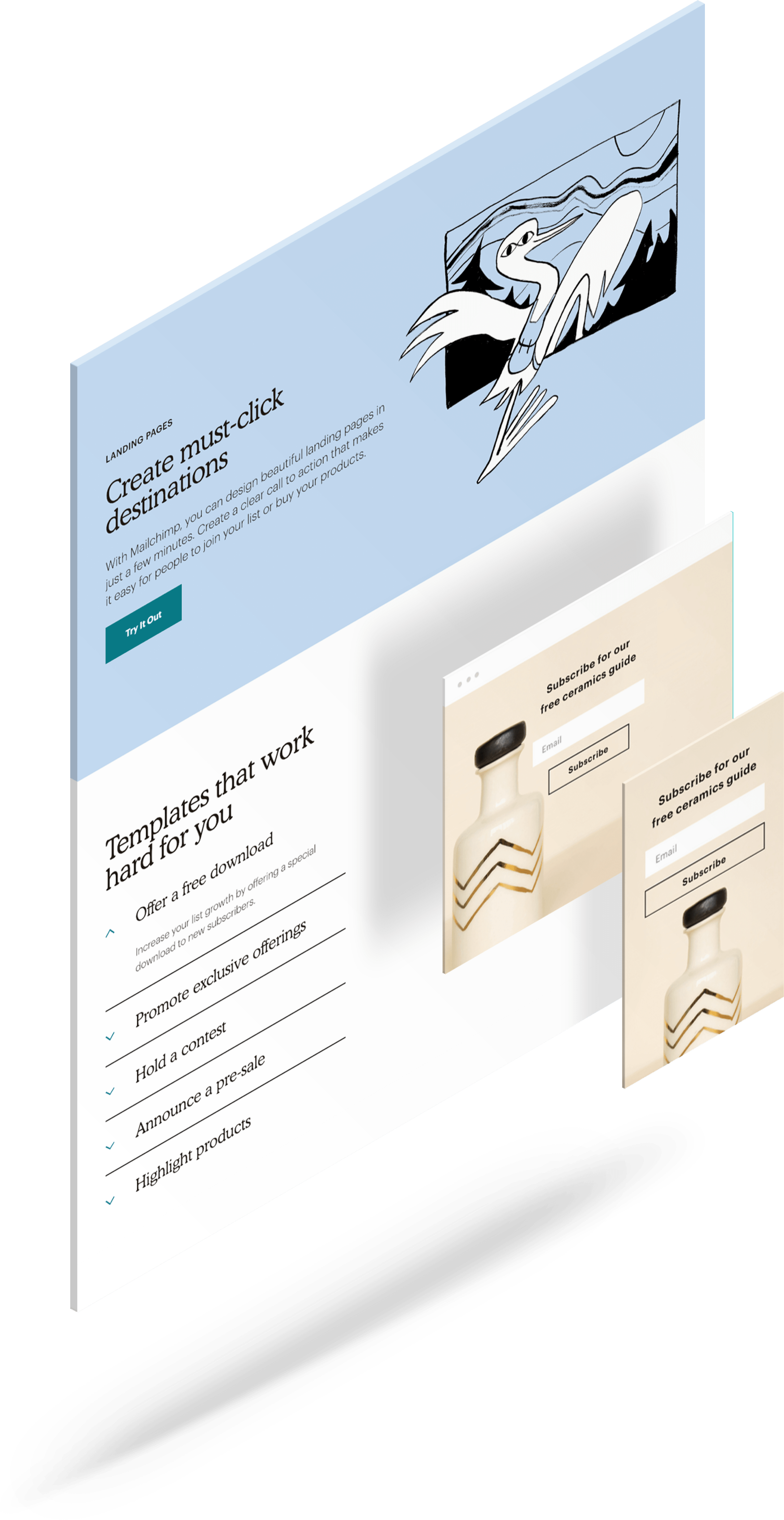
Find out why the user hasn't taken action
We’ve established already there’s plenty you can learn about users simply by asking them. That isn’t just limited to one-on-one interviews; with marketing automation, you can learn more about your users at scale and tailor future content to their preferences.
Mailchimp knows that I haven’t been engaging with their emails or using my account all that much, so they could try asking me why I haven’t yet. An example of what that could look like comes from HubSpot, who dramatically increased engagement with their content by asking users what their goals were and using that answer to provide more relevant content later on.
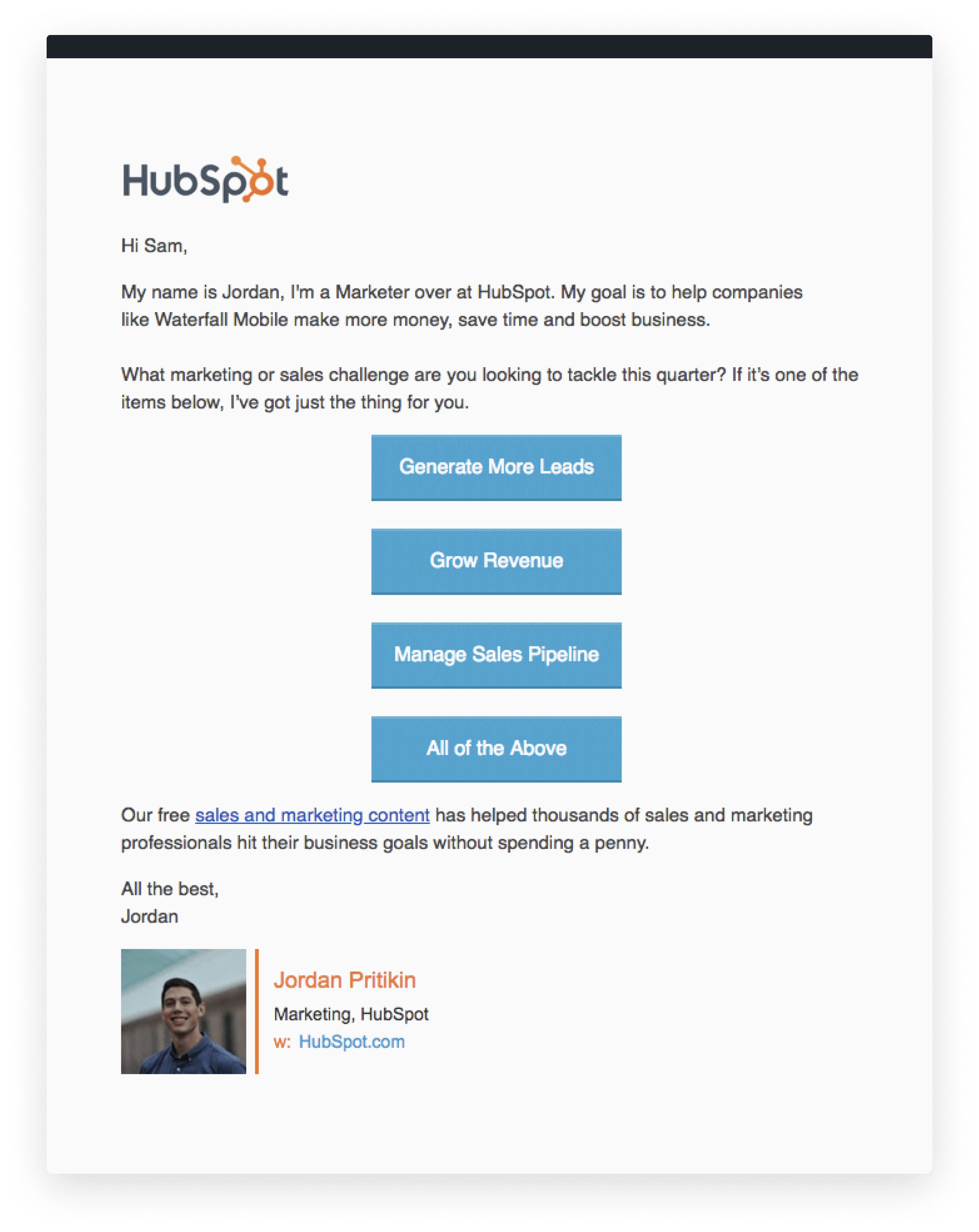
Users can answer with a single click, and HubSpot can use that click to trigger new workflows. While this example is geared more towards education than onboarding, it’s easy to imagine how this format can work to pose questions at pretty much any stage of the customer journey.
In fact, Mailchimp’s onboarding flow does have something similar to help identify how users measure success. Mailchimp prompts you to fill out this onboarding survey when you log in to a new account, and uses the answers provided to customize the tips that appear in the user’s dashboard.

This survey serves as a great introduction to Mailchimp for a few reasons:
It’s the most interactive and personal part of Mailchimp’s onboarding
It helps the user envision all the potential ways they can use Mailchimp
The answers help Mailchimp understand what the user needs to learn next
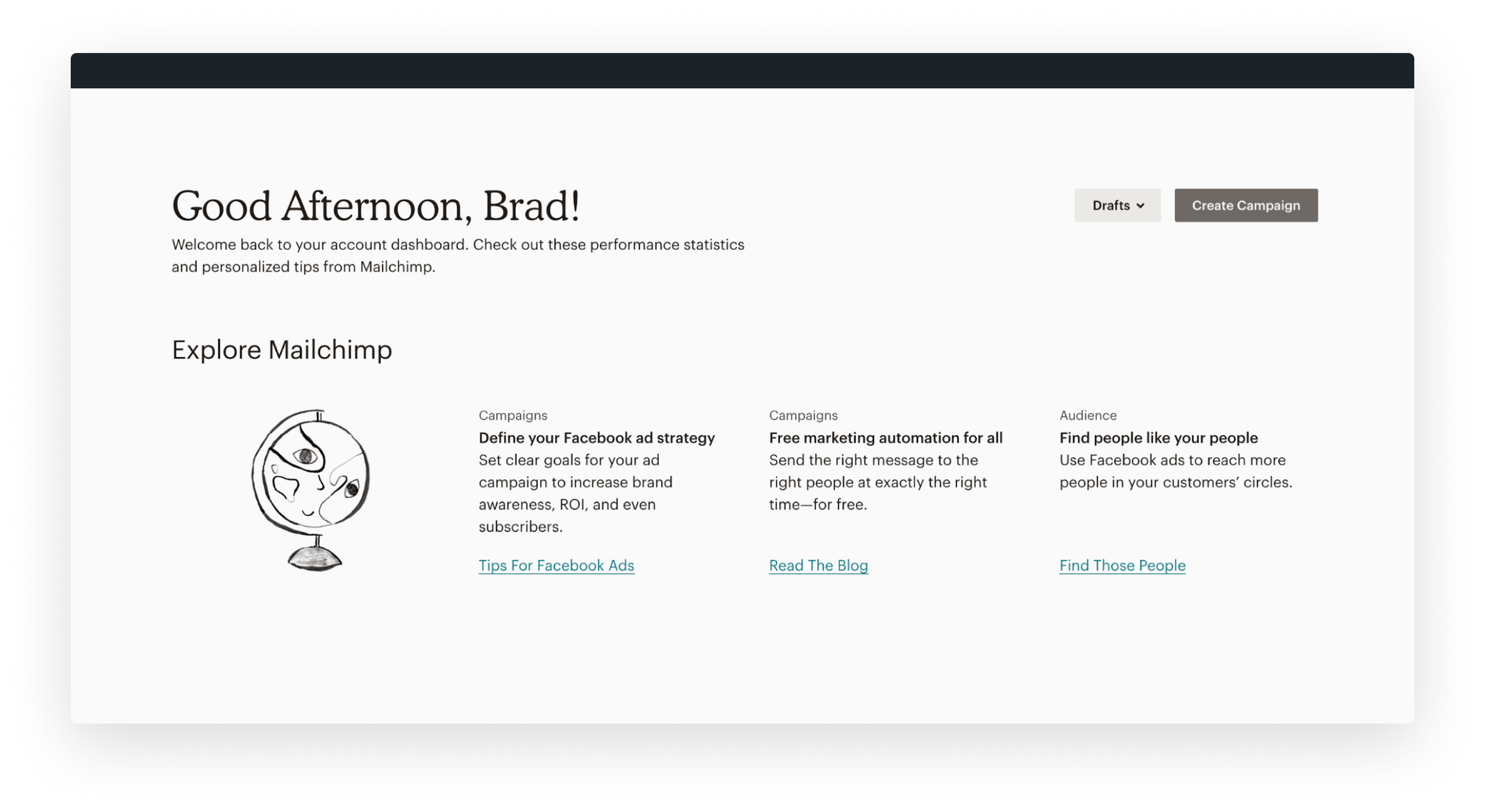
But interestingly, this survey is never mentioned in any of Mailchimp’s onboarding emails, these questions never asked. I actually didn’t see this survey until I logged in long after Mailchimp’s 10-email onboarding flow had ended, and I’ve never received any emails from Mailchimp since completing it.
Had this been included early-on as part of Mailchimp’s email onboarding campaign, the onboarding emails themselves could have been customized precisely to my goals; instead, I received the same set of emails as any other Mailchimp user, many of them irrelevant to what I wanted to achieve.
Again, the content of this entire campaign is great, and perhaps it’s meeting all of Mailchimp’s goals as-is. It’s because the content is great, though, that it’s easy to imagine how it could be elevated by more targeted messaging that guides each user towards relevant, clearly communicated goals.
Recap on the onboarding stage
Many users sign up for products, free or paid, only to take zero action and churn a few months later. To have any chance at converting new users as real customers, you need to help them discover value in your product as soon as possible. The fundamentals of this are the same as always — provide relevant content that speaks to your user’s motivations in the moment. The information you have about each user within your automation tools at this stage will allow you to create more tailored streams of content, driving your users to take action directly within your product.
Stage 4: Engagement
Engage users who’ve experienced your product’s value only infrequently, giving them ever more reasons to return to your product.
Once you’ve onboarded a user, you’ve successfully helped them experience first-hand the value of your product… once.
That’s something worth celebrating, but not too much. Yet many companies essentially stop marketing to their users at this stage, assuming that once a user understands how their product works, they’ll be good to go.
As your customer research will likely reveal, it doesn’t quite work like that. Your users will develop new motivations and hit unexpected obstacles as they become more familiar with your product, what it’s capable of is and what it isn’t. Proactively communicating to customers at these moments can mean the difference between building a lifetime relationship and losing them to a competitor.
In the engagement stage, you’ll take users that have experienced your product’s value just once or infrequently, and upgrade them into fully engaged users that consistently find reasons to return to your product. If users are moving in the opposite direction, becoming less engaged with your product over time, then you’ll want to find out why and help them get back on track.
When creating content for this stage, there are three key user segments to consider:
Unengaged users: These users have experienced your product’s value first-hand during onboarding, but are yet to consistently engage with your product.
Disengaged users: These users were once fully engaged users of your product, but their usage has become less frequent.
Inactive users: These users were once fully engaged, but now never or almost never use your product.
Once users become fully engaged with your product, they leave the engagement stage and move onto the next and final stage in this model, loyalty. But that doesn’t mean they’ll stay there.
What complicates content creation and distribution in the engagement stage compared to prior stages is that it’s possible for users to complete this stage by becoming engaged, only to come back again later if they eventually start disengaging from the product — something that isn’t exactly uncommon.
Unengaged users have completed onboarding but have never qualified as engaged; disengaged and inactive users have completed your engagement stage before, but are either disengaging from your product or have already largely abandoned it. Each segment requires a slightly different approach.
Unengaged users are still new to your product and determining if it’s truly fit for purpose long-term, so it’s important to carry through the momentum from the onboarding stage by continuing to drive towards product features and educational content that connect directly with the motivations that brought them to your product in the first place.
Disengaged users aren’t new to your product. They’ve engaged with your product before and seen how it delivers value, but for whatever reason that value has become less compelling. Maybe they’ve realized your product doesn’t quite do what they expected it to; maybe it does, but the nature of their problem or their role has fundamentally changed; or maybe they’re getting exactly what they need with less usage than you anticipated. Uncovering which obstacles are preventing users from engaging further and driving them towards content that helps surmount or sidestep them should be the focus for this segment.
Inactive users never or almost never use your product or get value from it, even if they’re still paying for it. Being too frequent or familiar in your communications to inactive users can drastically backfire, actually prompting them to make a clean break from your product. Reach out to these users only when you have something truly valuable to offer or announce, or if you’ve made a breakthrough in the issues that caused them to stop using your product in the first place.
Uncovering the real reasons why users are failing to engage with your product is one of the most challenging parts of building effective relationship marketing. While customer interviews can provide insights on the most common obstacles users face, they can’t help you identify the obstacles any individual user of your product is facing at a given point.
This is where measuring user engagement within your product can really prove its worth. By this stage, you should have a reasonable collection of triggered actions that tell you more about what content a user has previously consumed and the reasons why they came to your product. Users may choose your product with a goal in mind, but can easily miss parts of your product that are relevant to achieving them. Track engagement in-product with features that are most relevant to the motivations and obstacles you’ve identified, and continue to drive users towards valuable features that they might have missed.
Let’s take another look at email startup Superhuman. One of the ways it delivers its core benefit of speed is through the ability to execute actions through keyboard shortcuts and written commands. This is a much faster approach than selecting options from menus, but isn’t as immediately discoverable.
Superhuman works around this with short, to-the-point emails that quickly let the user know what benefit a feature provides and how to start using it. Here’s one example on snoozing messages for later:
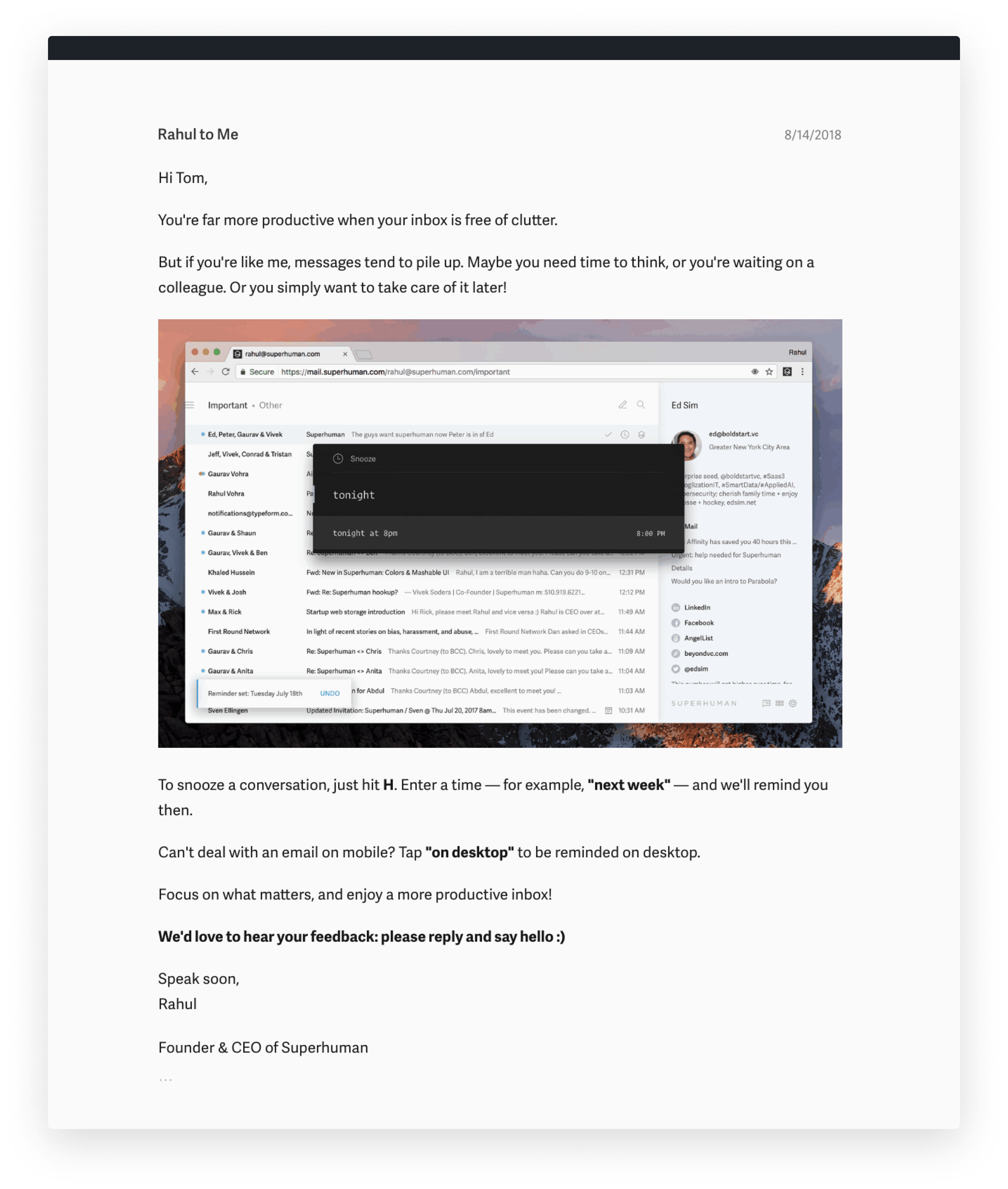
While it’s likely Superhuman sends this email to any user regardless of whether they’ve used the snooze feature before, it’s to you and your user’s benefit to track feature engagement and use each email or other communication as an opportunity to show your users something both new and relevant.
Another effective way to find out what’s holding users back is to, like always, simply ask. Many companies wait far too long to start asking for feedback, only discovering a user’s negative impressions once they’re nearly set in stone, or making their feedback mechanisms so complicated that only the most dedicated or furious users fill them out. And the vast majority of users that experience problems simply never say anything.
You should consider what user feedback looks like for the unengaged, disengaged and inactive segments of your user base, how you can identify when users are having a negative experience as soon as possible and how you can help them correct course.
Eliminating the friction in giving feedback, big and small, is a simple step towards achieving this. How many survey emails have you received with a lengthy preamble about how much your time and feedback is valued, followed by a form more complex than a final exam?
In the onboarding section, we looked at an email from HubSpot that allows users to answer what their primary goal is simply by clicking the relevant link. The below email from Apple is similarly simple — they ask how satisfied the user was with their experience and let them immediately pick an answer within the email, with the full survey (just a few questions long) opening in a new tab once an answer is selected.
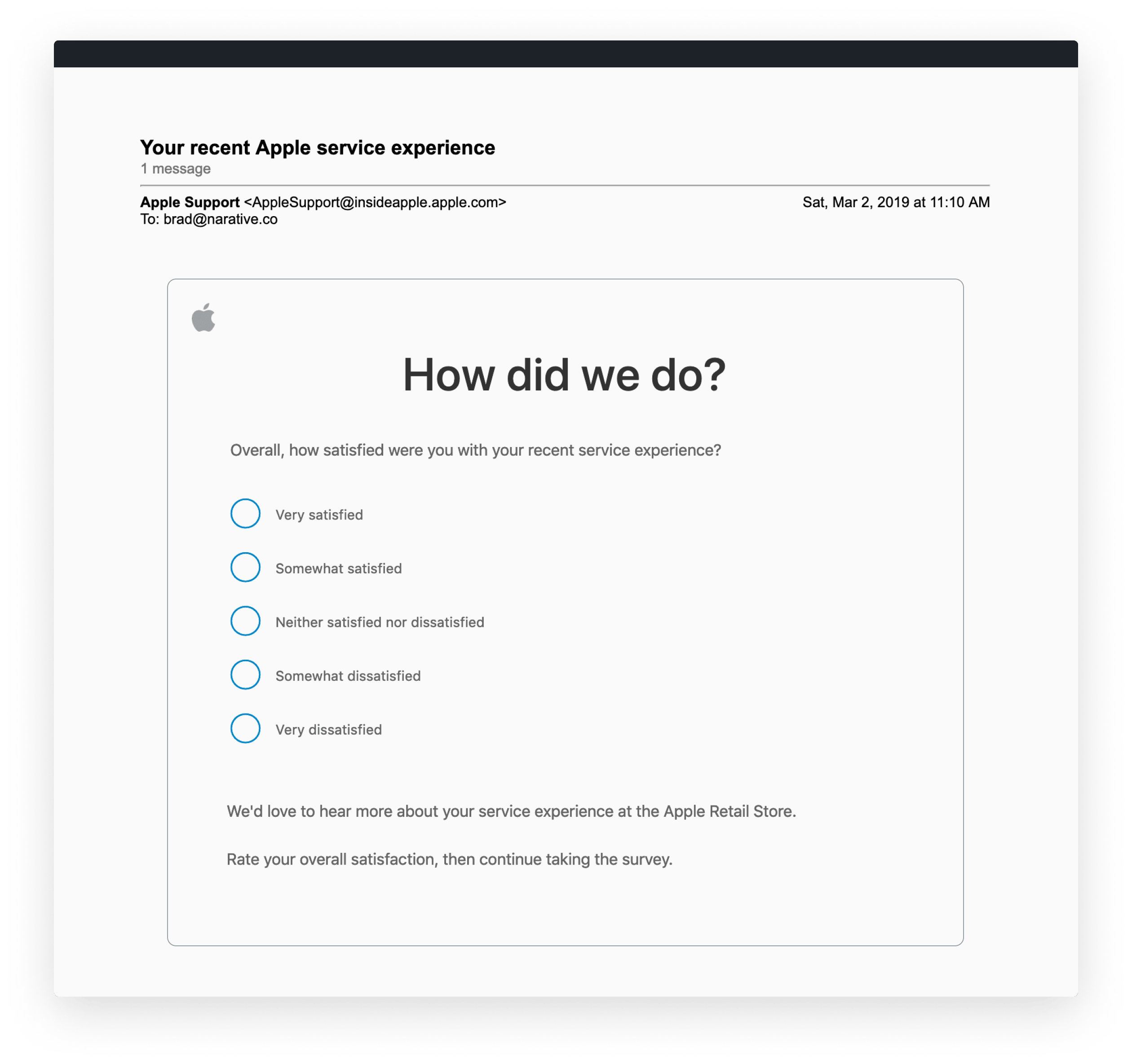
Many companies that implement surveys like the above, or other systems like star ratings or Net Promoter Score, never follow up with the users after they leave feedback. From the user’s perspective, this makes providing any feedback a thankless task, which will either diminish their positive impression or reinforce a negative one; from the business’s perspective, it leads to missed opportunities to strengthen and salvage relationships with customers.
That’s why you should always act promptly on user feedback, through both your automated and one-on-one interactions with users.
In response to negative feedback, you should immediately move users out of any active workflows, even if they’re fully engaged; continuing to send frequent marketing communications without addressing their issues could frustrate them further. Any communications you send from this point on should address their feedback, whether that’s an invitation to chat with a member of your team, or helpful content that can help your customers overcome those challenges themselves. It’s important to show that you both acknowledge their negative experience and are prepared to make it better, rather than trying to pretend it didn’t happen.
Users that give you strong positive feedback can be assumed to be more receptive to further engagement than those that haven’t (unless your data starts telling you otherwise!). Double-down on communications about the parts of your product they love, while experimenting with more frequent communications and new formats. Pay close attention to how these campaigns perform, as the last thing you want to do is begin alienating users who are feeling good about your brand. These users also make great interview candidates for understanding what really works about your product.
Any feedback should be included as part of a user’s profile in your CRM platform so that you can use it to trigger actions and have it available for easy viewing when talking with customers.
Multiple choice answers make it much easier to collect and use this data, but be careful not to overdo it — first-time feedback shouldn’t take more than a few minutes to complete, and your provided options won’t account for everything a user wants to say. Be sure to include open text fields in any feedback fields or surveys you send out, so your users can express their thoughts and perspectives in ways that radio buttons simply cannot.
Finally, while collecting and responding to feedback is important, it’s ultimately meaningless if that feedback doesn’t make its way into improvements to your product. Analyzing and applying user feedback requires visibility and collaboration across every team in your organization, and prompt consensus on which feedback is most critical to act on. Remember to always look to your user’s motivations as your north star.
Recap on the engagement stage
In the engagement stage, you’re dealing with three major audience segments: unengaged users that are newly onboarded, disengaged users that are slipping away, and inactive users that are already gone. Your mission is to upgrade them all into fully engaged customers, measuring their in-product activity and providing ample opportunities for explicit feedback so you can measure which customer relationships are healthy, and which need to be quickly turned around.
Stage 5: Loyalty
Retain and create more value from your happiest customers.
Customers in the loyalty stage are fully engaged users of your product. Your goal in this stage is to retain that engagement, continuously building customer satisfaction and providing ever more reasons for users to love your product — and to tell the world that they do.
A common approach companies take to generating positive word-of-mouth is to incentivize users with cash or cash-like benefits in exchange for referrals, social media shares and reviews. Even in the event that campaigns like this can score you a few new users, they're unlikely to create significant long-term value unless they’re a true market fit.
Your most important referrals will come from customers that truly believe in your company and product, and speak to its worth to friends, colleagues and industry peers — not in insincere one-off posts or desperate messages appended with referral links, but in continuous conversations both in-person and online.
They're the ones that will continue to advocate for your product even as they face new challenges or switch roles. They're the ones that say stuff like this:

Positive word-of-mouth is a mere outcome of meeting the real goal in building customer loyalty: continuously delivering perspective-changing value.
Invest in truly delightful customer care
The word “delightful” gets unjustifiably thrown around in conversations around digital marketing, but customer service is one area where delight is a real factor.
When customers hit obstacles and reach out to your team for help, it's one of the biggest opportunities to impact how they see your company, for better or worse. It means taking an anxious or frustrating experience and turning it into a positive one — or blowing it up into something much worse.
Positive customer service experiences are the ones that convince customers to stick with your company through thick and thin, and give people a reason to talk about their experience with others. At a company I previously worked with, customers that experienced problems and contacted customer care to resolve them were more valuable to the business long-term than customers that reported no issues. Interactions with customer care can turn negative situations into a net positive, resolving any issues and actually strengthening belief in the brand.
Negative service experiences are just as impactful in the opposite direction. Your users might start talking more about your product, but they won’t have much nice to say. After a negative interaction leaves your customer feeling personally slighted, they’ll start looking for any reason and every opportunity to switch away from your product, even if it’s doing its job well.
An unfortunate truth of the tech world is that even companies that invest in building large customer care teams tend to under-invest in those employees, resulting in cultural and informational silos, high turnover, regular loss of institutional knowledge and an overall worse experiences for customers. This is despite the fact that not only do talented customer care employees contribute immensely to a business's bottom line by creating advocates for your brand, they tend to be some of a company's most vocal advocates themselves. Take good care of your team, and empower them to take good care of your customers.
Create opportunities for dialogue, and come prepared
Customers at this stage are usually happy to talk, and can reflect on and provide insights on their motivations, obstacles and moments of truth across every stage of the customer journey. If you’re looking for candidates for customer research, customers in this stage are a great place to start.
As engaged users of your product, they’re likely to have plenty of detailed feedback both on what’s working and what their challenges are, and conversations with them can inspire new ways your product can create value for both your customers and bottom-line. (Just don’t limit your research to only your loyalest customers.)
Testimonials and case studies can be powerful motivators for new users to give your product a shot, and customers in this stage are one of the first groups to look to for providing them. The process of interviewing for them can even be a doorway to a stronger relationship between your customer and your company, but only if you approach it right.
The quickest way to turn your customers off the conversation is to forcefully guide it towards the topics you’re interested in, transparently angling for that perfect quote with all the right keywords to support your big feature launch or PR push. The story you’re imagining, though, is likely nowhere near as interesting as the story your customer is waiting to tell you.
Frame the conversation around what your customer is passionate about, excitements and frustrations both. Dig deep into the details behind each answer, and you’ll naturally discover what your product really means to them.
You don’t want to script your customer’s testimonials for them, but there are other ways to get the perfect quote. One approach I’ve always found to be effective and appreciated by customers is letting them know ahead of time that I’ll be writing a testimonial on their behalf that accurately reflects what they said across our entire discussion, giving the interviewee themselves ultimate approval power. Customers usually appreciate the transparency of the process and the quality of the resulting quotes as long as it’s done with integrity.
Look for new problems to solve, and let your customers help
Your most engaged users are also the ones that will push your product to its limits, hit unexpected obstacles and develop new motivations beyond what originally brought them to your product.
These are exactly the areas in which competitors will look to disrupt your business — but these insights also present opportunities to develop new products and services, either to increase product engagement or to add new revenue streams.
Customers in this stage are also the perfect audience to help you test out those new opportunities in the form of early access or beta programs.
Don’t forget the value of your awareness and education content
If your customers were drawn to your product because of your company’s content or its perspective, they’re likely still interested. Don’t discount the value of that content in keeping users engaged even in the later stages of the customer journey. Continuing to deliver new content that’s relevant to your customers will only strengthen their relationship with your brand, and give them more reasons to share it with others.
Recap on the loyalty stage
Customers in the loyalty stage represent your most engaged and valuable audience. In this, the final stage of the customer journey, your goals are to retain that engagement and grow the value of those relationships. That happens when you continuously find new ways to deliver value to those customers, whether that happens through your content online or through your customers’ direct interactions with your team. Consider how you can use those direct interactions to bring more insights to your marketing and product design.
Measuring and optimizing impact
For many businesses, the implementation of marketing automation or CRM platforms often starts with the desire to track and optimize certain key metrics, be those lead generation, customer acquisition or retention.
Relationship marketing does give us the tools to drive those metrics, and measuring the impact of your relationship marketing is critical to its success. Without doing so, you’ll never know what’s working, what you need to improve and how your efforts are affecting the business at large.
However, over-focusing on a narrow set of metrics can be extremely destructive. Relationship marketing is about improving the totality of your customers’ experience with your brand, and generating more profit in the process. You need to track the impact across the entirety of the customer experience and your company.
That’s why we’re going to look at two sets of metrics to track: stage goals and health metrics.
Stage goals are your primary goals in each stage and are defined by the actions that lead into the next stage of the customer journey, such as collecting a user’s contact information or getting them into your product. The conversion rate measures the percentage of users that enter each stage and successfully complete the stage goal.
Health metrics track the impact of your marketing activities across the customer journey in ways that your conversion goals might not fully capture. For example, if you’re successfully getting more users into your product but your cost-per-acquisition and churn are on the rise, it’s worth reconsidering whether those tactics are having their intended benefit across your business as a whole.
Next, we’ll explore how to define and track each stage goal, along with the health metrics that will help keep your product’s marketing on track.
Awareness goal: contact (email) acquisition
Conversion rate: The percentage of visitors to your site that provide you with their contact information before becoming leads or product users.
Your relationship with users begins as soon as they make a mental connection between your product and their needs or problems. To actually build on that relationship, though, you need to be able to connect directly with users without waiting for them to always come back to you first. And to begin tracking and acting on user behavior in your marketing automation tools, you need some way to actually identify each user.
That’s why the ultimate goal in the awareness stage is to collect a user’s email address and their consent to reach out to them in the future. It’s important to note that a contact is not a lead, and collecting people’s email addresses isn’t lead generation on its own — nor is it permission to reach out to them about anything and everything.
If someone subscribes to your content or provides their email in exchange for something specific, abusing the privilege is a quick way to get yourself booted out of your potential customers’ minds and inboxes.
Finally, while collecting a user’s contact information is the goal to track in this stage, your ultimate goals are getting into the minds of prospects, and then getting them into your product. Companies that are too aggressive with their calls-to-action or gating their content can end up turning extremely qualified prospects away, while limiting their discoverability on search engines and social media.
Education goal: product entry
Conversion rates: The percentage of both visitors and contacts that become first-time users of your product.
Depending on your business model, the way a user first gets into your product can look very different. Regardless of whether your company offers free trials and self-serve signups, or requires a lengthy qualification and sales process, the end goal of the education stage is always the same: get users into the product for the first time.
If you do offer self-serve signups, though, it’s possible for product signups to be the first time you ever collect a user’s contact information. So measure the conversion rates of both contacts and visitors to product signups to get a complete picture of how users are getting into your product.
Onboarding goal: value delivered
Conversion rate: The percentage of users that sign up for your product and have its core value delivered to them.
The goal of your onboarding is to get users to experience value as quickly as possible — the kind of value that convinces them to stick with your product beyond first blush. But how do you measure when that first value has been delivered? When do users cross the threshold between curious and convinced?
For Slack, that threshold is 2,000 messages sent. As Slack co-founder Stewart Butterfield explained, “for a team around 50 people that means about 10 hours’ worth of messages. For a typical team of 10 people, that’s maybe a week’s worth of messages. It hit us that, regardless of any other factor, after 2,000 messages, 93% of those customers are still using Slack today.”
Twitter has a similar goal: get new users to follow 30 accounts. Most products have activity thresholds that, once crossed, indicate that users are beginning to find value in the product, are far more likely to stick with it beyond onboarding.
What are the “magic numbers” that indicate new users are beginning to see value in your product? Those metrics are how you’ll define when new users have had first value delivered (often abbreviated as FVD).
Customer research can give you insights on where to look, but the only way to actually measure and act upon it is to track engagement within your product, and sync that data back to your marketing automation tools.
Engagement goal: fully engaged
Conversion rate: The percentage of users that sign up for your product and go on to become fully engaged users.
In this stage, you’re focused both on engaging new users and re-engaging existing users that have fallen off. The best way to define engagement depends on your product’s business model:
For services and subscription products, you’ll likely want to measure product activity.
For ecommerce and other transaction-based businesses, it’s better to segment based on the recency and frequency of transactions, and how much those transactions are worth.
Like with Slack’s 2,000-message onboarding goal, you want to be on the lookout for thresholds that once crossed indicate a user is likely to stick with your product long-term.
The most common method of defining user engagement is by how often a user accesses a product during specific timeframes, measured as daily, weekly or monthly active users. But this doesn’t tell you what the right amount of engagement actually looks like for your product.
Andreessen Horowitz partners Li Jin and Andrew Chen present the more nuanced idea of the “power user curve,” which looks at the number of days all users access a product within any given timeframe. As their examples show, what defines an engaged user can look very different for a consumer social product versus a professional networking product.
For the consumer product on the left, an extremely engaged user is visiting every single day. For the professional networking product on the right, the most engaged users visit around 10–20 days within a month, with over three-quarters of users visiting fewer than four days per month.
Just visiting isn’t always an indicator that users are getting continuous value from your product, so you can also track engagement by core product activities, like in the content posting example below:
You want to encourage more of the right kind of engagement, and not just needlessly drive your customers back into your product. If your typical engagement rates are low but users are still extremely satisfied with your product, consider ways to generate more value from those engagements instead of artificially driving frequency up.
If your business isn’t a service or subscription product, and relies instead on repeat purchases — such as ecommerce — it’s more effective to measure customer engagement based on their transactions with you.
Known as Recency, Frequency and Monetary (RFM) analysis, this model has you rank customers in three areas:
Recency: How recent was their previous transaction?
Frequency: What’s the average time between transactions?
Monetary: What’s the average value of each transaction?
Plotting these values on a curve similar to the power user curve above can help you uncover what the typical recency, frequency and monetary values look like for your product.
Users that have purchased recently are engaged; users that have purchased less recently are disengaged; and users that haven’t purchased in a long time, on the lowest end of your recency curve, are inactive.
From there, break down all engaged, disengaged and inactive users by the frequency rate of their purchases and how much those purchases are worth on average. Segmenting your customers this way makes it easy to identify the customers that are worth the most to your business, along those you need to urgently re-engage and those that are honestly not worth the effort.
Loyalty goal: lifetime value (LTV)
Since this is the final stage of the customer journey, the goal isn’t to convert users to another stage — it’s to continue growing the lifetime value (LTV) of the customer relationship, which measures the revenue generated by each user minus the costs to acquire and support them.
Different companies approach measuring LTV in different ways. Some only include revenue and expenses already been generated from the customer relationship, whereas others include projected future cash flow and costs based on the average across all customers.
While including future revenue based on contract length is a fairly safe bet, using current average LTV and churn rates to project future revenue can be extremely risky, as there’s no guarantee those rates today represent the future realities of your business.
In addition to growing LTV, you’ll want to keep a close eye on how your actions in this stage influence health metrics like ARPU, user feedback and churn, which we’ll dig into next.
Health metrics
As you iterate on your relationship marketing campaigns, you’ll want to focus on improving the conversion rates for each stage goal. But in the process, it can be easy to focus on optimizing the numbers themselves rather than the outcomes they represent, or to miss the unintended consequences of our actions. Health metrics help keep us honest and informed.
Tracking the following health metrics alongside your conversion rates for each stage let you know if your actions are having their intended impact and if you’re focused on the right problems. This list isn’t exhaustive, and it’s likely your company tracks some of these already (though not always the marketing teams!). Consider which other metrics matter most to your business.
Bounce Rate: The percentage of visitors that leave your site after viewing only a single page, without taking any other action. There’s no universal benchmark for a “good” bounce rate; articles can have extremely high bounce rates, for example, and still be effective at their goals. However, if the majority of paid and organic traffic to your website is bouncing, it could be a sign that they’re not finding what they’re expecting to.
Cost Per Acquisition (CPA): The average cost to your company to acquire a contact, a lead, trial signup, free plan user or anyone that is not a paying customer. These costs include all overhead involved in acquiring new users, including the cost of advertising, software, team salaries, rent and any other expenses.
Customer Acquisition Cost (CAC): The average cost to your company to acquire and retain a paying customer, including any previous CPA costs and expenses involved in delivering and supporting the product.
LTV:CAC Ratio: This compares the lifetime value generated from a customer against the cost of acquiring them. The closer you get to 1:1, the closer you are to losing money on each user you acquire. Track shifts in your LTV:CAC ratio to know when you’re spending too much or too little on acquisition.
Unsubscribe Rate: The percentage of users that unsubscribe from receiving email communications from you. Anything above 1% should be cause for concern; either your list is outdated, your subscribers didn’t realize what they were getting into, you’re contacting them too frequently or your content isn’t hitting the mark.
Churn: The percentage of users that stop using your product during any given timeframe, such as quarterly or annually. One of the goals of relationship marketing is to lower churn, but over-aggressive marketing can have the opposite effect. While getting new users into the product is important, it’s pointless if those users don’t stick around. If your churn rate is rising alongside signups, it could be a sign that you’re marketing to the wrong audience, or not delivering on the expectations you set for them.
Average Revenue Per User (ARPU): Unlike LTV which looks at the lifetime value of customers on an individual basis and includes the costs required to acquire and support them, ARPU simply divides the total revenue generated across all users during a set time period, such as monthly or annually. This is important because it lets you know how effective you are at monetizing each customer relationship, but indicates little about long-term satisfaction.
User Feedback: If you have quantifiable user feedback — such as review or NPS scores — then be sure to track those metrics. But equally important is qualitative feedback from customers and front-line employees, in the form of open-ended messages and discussions. This information doesn’t fit neatly in a dashboard, but it will convey information that numbers cannot, so be sure to review and summarize it frequently and distribute those summaries across teams.
Recap on measuring and optimizing impact
Success in each stage of the customer journey is measured by a single stage goal per stage; when users complete those stage goals, they move onto the next stage of the customer journey. But the conversion rates of those goals alone provide only a narrow picture of the impact your marketing has, and focusing on them alone can cause consequences in areas you aren’t focused on. Health metrics help you measure the positive and negative consequences of your campaigns, across every aspect of your business. Remember that metrics are only valuable when they honestly represent positive outcomes for your customers, and that your mission is to optimize the experiences those numbers measure — not the numbers themselves.
Nine steps to taking action
The most difficult part of building out relationship marketing is simply getting started. The below steps will help you get to work right away, and start generating insights and impact as soon as possible.
Understand where your existing traffic and customers come from, how much it costs to obtain them, and what happens to them after they arrive or sign up. Your health metrics can highlight a lot of early issues here, as well as looking at the behavior flows users take through your site in Google Analytics.
Leverage any recent and relevant customer research in your organization if it exists, and get started on new interviews that help you uncover your customers' motivations, obstacles and moments of truth.
Take inventory of all of your existing content: web pages, articles, emails, videos, webinars, ads, sales materials, in-app tutorials, everything. It's important to get a complete view of the message you send to customers and understand where you might be missing the mark.
Meet with colleagues to align on what the important outcomes are for your company and what your research shows matters to customers. If there’s misalignment between what internal stakeholders want and what users need, it needs to be addressed now. If not, your health metrics will show the negative impact later.
Research which marketing automation platform is best for your business and begin implementing it, if you don’t have any in place already. Some of the most popular options have been mentioned throughout this piece, and you can find a comprehensive list of what’s on the market at G2 Crowd.
Map out your customer journey stages and determine which metrics to track in your stage goals. You can use the 5-stage structure presented in this piece as-is, or change it up to suit your business model. Just don't over-complicate things.
Look at the content you’ve inventoried and determine which pieces can be used in which customer journey stages. If the motivations or the message of a piece of content don't align with what your internal and external research highlight, trash or rework it. If new content and messaging is necessary, get to work creating it!
Launch your first automated campaigns, starting with small and simple workflows with a relatively high volume of contacts. Watch the results closely and quickly address major issues until your baseline metrics stabilize.
Iterate constantly. The biggest benefits of relationship marketing come as you figure out what works over time, and those insights come from testing dramatic changes. Keep an eye on how each change impacts your stage goals and health metrics; roll back on what fails, and double down on what works.
Beyond technical challenges and simply getting the work done, the biggest barrier to building effective relationship marketing and strengthening product-market fit can be convincing everyone in a company that it’s even worth doing.
Teams and individuals are incentivized to deliver quick wins that are reassuring in the short-term, but meaningless in the long-term; cross-departmental collaboration can be seen as a bottleneck by those who’d rather go it alone; and few enjoy having their presumptions picked apart by the new knowledge that customer research can bring.
But the long-term health of any business depends on its willingness to meet its market. To retain a market requires constant attentiveness and adaptation to what customers within it want. To grow a market requires a deep understanding of those customers’ current challenges. Organizations that are unwilling will be consumed by competitors that are.
Existential imperatives aside, there are few things in this industry more satisfying than confidently meeting your customer’s needs and getting to see the impact first-hand — both in the numbers, and in customers’ own words.
Thank you
I created this guide in the hopes of creating the kind of in-depth resource I wished I had when I embarked on this journey many years ago, built on not just my own experiences, but the knowledge of my many incredible colleagues and the talented people I've quoted within.
It means a lot to me that you’ve read this entire piece. I hope you’ll consider sharing it with your team and exploring these ideas together.
If you have questions, comments or critique, I’d love to hear from you. You can reach me on Twitter @bradtiller, or via email at [email protected].